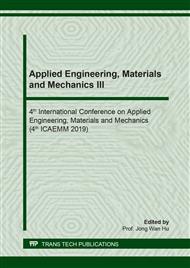[1]
Z. Z. Chen, R. Y. Li., J. W. You, K. S. Li, Mold Design and Analysis for Inject Molding Process of Plastics Materials, Wunan Book Co., Taipei City, Taiwan, (2017).
Google Scholar
[2]
C. Lee, X. Wei, J. W. Kysar, J. Hone, Measurement of the Elastic Properties and Intrinsic Strength of Monolayer Graphene, Sci. 321 (2008) 385-388.
DOI: 10.1126/science.1157996
Google Scholar
[3]
S. N. Tripathi, G. S. S. Rao, A. B. Mathur, R. Jasra, Polyolefin/graphene nanocomposites: a review, RSC Adv. 7 (2017) 23615-23632.
DOI: 10.1039/c6ra28392f
Google Scholar
[4]
S. Sheshmani, A. Ashori, M. A. Fashapoyeh, Wood plastic composite using graphene nanoplatelets, Int. J. Bio. Macromolecules, 58 (2013) 1-6.
DOI: 10.1016/j.ijbiomac.2013.03.047
Google Scholar
[5]
M. A. Milani, D. González, R. Quijada, N. R. S. Basso, M. L. Cerrada, D. S. Azambuja, G. B. Galland, Polypropylene/graphene nanosheet nanocomposites by in situ polymerization: Synthesis, characterization and fundamental properties, Compo. Sci. Tech. 84 (2013) 1-7.
DOI: 10.1016/j.compscitech.2013.05.001
Google Scholar
[6]
S. Sheshmania, A. Ashorib, M. A. Fashapoyeh, Wood plastic composite using graphene nanoplatelets, Int. J. Biol. Macromol. 58 (2013) 1-6.
Google Scholar
[7]
K. M. B. Jansen, D. J. V. Dijk, M. H. Huesselman, Effect of processing conditions on shrinkage in injection molding, Polymer Eng. Sci. 38 (1998) 838-846.
DOI: 10.1002/pen.10249
Google Scholar
[8]
H. H. Lee, Taguchi Methods: Principles and Practices of Quality Design, Gau Lih Book Co., Taipei City, Taiwan, (2011).
Google Scholar
[9]
E. Aliakbari, H. Baseri, Optimization of machining parameters in rotary EDM process by using the Taguchi method, Int. J. Adv. Manuf. Tech. 62 (2012) 1041-1053.
DOI: 10.1007/s00170-011-3862-9
Google Scholar
[10]
M. C. Huang, C. C. Tai, The Effective Factor in the Warpage problem of an Injection-Molded part with a Thin Shell Feature, J. Mater. Proc. Tech. 110 (2001) 1-9.
DOI: 10.1016/s0924-0136(00)00649-x
Google Scholar
[11]
C. B. Yang, W. C. Peng, Y. W. Huang, H. L. Chiang, Analysis of injection molding parameters for graphene/polypropylene composite material with thermal conductivity as quality objective, 2018 IEEE Int. Conf. Adv. Manufact. (IEEE ICAM 2018) 152-154.
DOI: 10.1109/amcon.2018.8614873
Google Scholar
[12]
R. A. Fisher, Statistical methods for research worker, Oliver & Boyd, London, (1925).
Google Scholar


